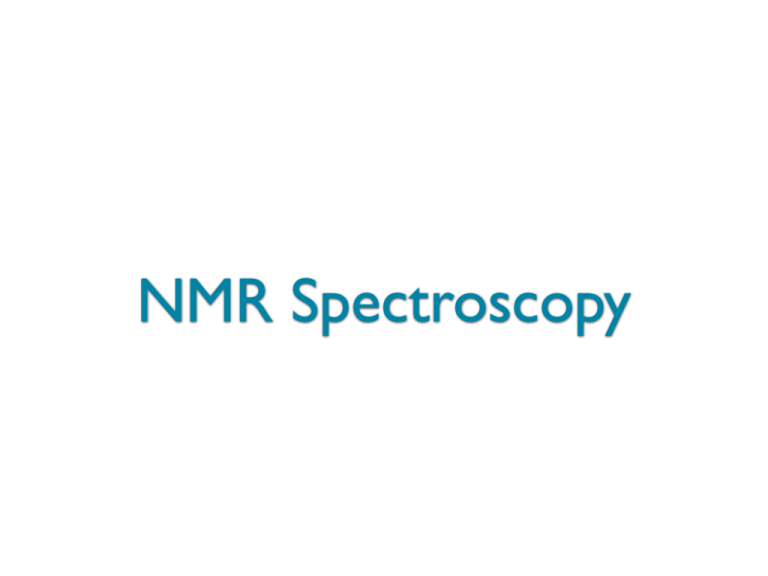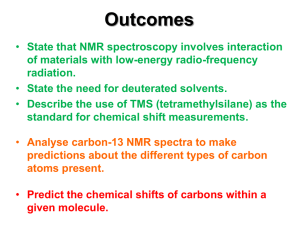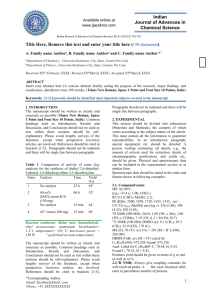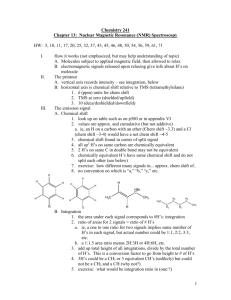NMR Handout - The Cook Group @ NDSU
advertisement

NMR Spectroscopy NMR Phenomenon ‣ Nuclear Magnetic Resonance µ A spinning charged particle generates a magnetic field. A nucleus with a spin angular momentum will generate a magnetic moment (μ). If these tiny magnets are placed in an applied magnetic field (Bo), they will adopt two different states - one aligned with the field and one aligned against the field. The energy difference between these two states is what we are observing with NMR. B0 2 Nuclear Spin States aligned against B0 Energy difference between the states at a particular magnet strength. In the Rf range of the EM Spectrum. E aligned with B0 B0 When EM waves at this energy are directed at the nuclei - it will absorb. Spins will flip from lower energy to higher energy. At that energy, nuclei are “In Resonance”. 3 NMR Active Nuclei ‣ Many nuclei are “NMR Active” ‣ Spin Quantum Number I ≠ 0 H -- I = ½; 13C -- I = ½ ‣ 1 ‣ 12 C, 16O -- I = 0 -- Can’t be observed ‣ Other nuclei that are NMR active ‣ H (D), 14N, 19F, 31P 2 4 NMR Instrumentation 5 Magnetic Resonance Imaging ‣ NMR is the basis for MRI 6 To summarize µ A spinning charged particle generates a magnetic field. A nucleus with a spin angular momentum will generate a magnetic moment (m). When placed in a magnetic field (Bo), they will adopt two different states - one aligned with the field and one aligned against the field. B0 aligned against B0 Energy difference between the states at a particular magnet strength. In the Rf range of the EM Spectrum. E aligned with B0 B0 7 Methyl Acetate - Proton NMR O H3C C O CH3 8 Methyl Acetate - Carbon NMR O H3C C O CH3 solvent 9 Electronic Shielding - Local Environments Blocal Beffective = B0 - Blocal µ Actual magnetic field felt by the nucleus B0 Beffective 10 Methyl Acetate - Proton NMR O H3C C O CH3 11 Methyl Acetate - Carbon NMR O H3C C O CH3 O C solvent 12 Chemical Shift ‣ The difference in resonance frequency of a nuclei relative to a standard ‣ Most Shielded ‣ Relatively Inert ‣ Volatile CH3 H3C Si CH3 ‣ Resonance of standard is set to 0 CH3 TMS TetraMethylSilane 13 NMR Scale ‣ X-Axis - frequency axis NMR Spectrum Low Field Little electron shielding (more electron withdrawing groups) High Field More electron shielding (less electron withdrawing groups) peaks measured as a shift (in Hz) away from TMS 10 Hz Reference TMS 0 14 Different Spectrometer Frequencies ‣ Each specific instrument has it’s own magnetic field strength - resonace occurs at different frequencies. aligned against B0 100 MHz NMR 300 MHz NMR Energy difference between the states at a particular magnet strength. In the Rf range of the EM Spectrum. E aligned with B0 B0 Reference TMS 300 Hz 100 Hz 0 15 Standard Scale ‣ δ = ppm = Chemical Shift from TMS (Hz) Spectrometer Frequency (MHz) 100 MHz NMR 300 MHz NMR 100 Hz 100 MHz = 1.0 ppm 300 Hz 300 MHz = 1.0 ppm Reference TMS 1.0 ppm 0 16 NMR Scale 17 C13 NMR ‣ Difficult - Carbon 13 only 1.1% of all carbon. ‣ Number of different carbons ‣ Functional Group Regions 13C NMR R R δ O C R 200 R O C O C C OR C C NR2 C O 150 100 C N C X 50 0 ppm 18 C13 NMR OH 19 Symmetry ‣ Symmetry in molecules can make carbons “Chemically Equivalent” Cl O H3C C CH3 same electronic environment Br 20 Symmetry ‣ Some molecules have more than one mirror plane CH3 CH3 CH3 CH3 21 Symmetry CH3 CH3 CH3 CH3 22 Symmetry CH3 CH3 CH3 CH3 23 Substitution of Carbon ‣ The intensity of the peaks roughly correlates with the number of hydrogens on the carbon. 24 C13 NMR Regions 13C NMR R R δ O C R 200 R O C O C C OR C C NR2 C O 150 100 C N C X 50 0 p 25 Bromooctanol HO Br 26 Bromooctanal H O Br 27 Alanine Me-Ester HCl O OCH3 H3C NH3Cl 28 Alaninol OH H3C NH2 29 Alaninol - phthalimide OH O H3C N O 30 DEPT-C13 OH ‣ A - normal C13 ‣ B - CH carbons only ‣ C - Odd # up (CH3 and CH) Even # down (CH2) 31 Example from 13.7 Cl KOH ethanol or 32 A Real Example O O O NH NH NH O OR N O N O O O N O H2, Pd/C H2, Pd/C O O O NH NH NH OR O N O In the alkane region there would only be 4 peaks due to symmetry O N O O N O In the alkane region there would be 6 different peaks 33 The Answer Is . . . O NH O N O O NH O N O 34 Proton NMR ‣ Number of chemically different hydrogens ‣ Relative Ratios of protons (peak size) ‣ How many neighboring hydrogens ‣ Chemical shifts and functional groups 35 Proton Equivalency Diastereotopic Homotopic H H3C H H C H3C CH3 H3C C CH3 X H3C H C C H3C CH3 X H C C H2 CH3 Cl replace H's diastereomers Enantiotopic H X C H replace H's - same H H CH3 H3C H C H C H CH3 Cl H3C X C H C CH3 Cl replace H's enantiomers X H3C H C C H2 H CH3 H3C X C C H2 CH3 36 Proton NMR Scale ‣ Range 0-10 ppm 1H NMR H OH H C O C O H H H H H H H H H C C H H δ 10 9 8 H C C X 7 6 5 4 3 2 1 0 ppm 37 NMR Correlation Chart Typical NMR Chemical Shifts 1H Chemical Shift (ppm) 13C Functional Group Type C H Alkane 0.7 -1.8 10 - 60 Allylic or next to carbonyl 1.6 - 2.4 30 - 60 next to halogen or alcohol 2.5 - 4.0 20 - 85 next to oxygen of an ester 4.0 - 5.0 50 - 85 vinylic 4.5 - 6.5 110 - 150 aromatic 6.5 - 8.0 110 - 140 aldehyde 9.7 - 10.0 190 - 220 alcohol varies widely will exchange with D2O N/A carbonyl of ester, amide, or carboxylic acid (X = O, N) N/A 165 - 185 carbonyl of ketone or aldehyde N/A 190 - 220 C C H X C H O C O C H C H C H O C H O H O C X O C Chemical Shift (ppm) 38 Methyl Acetate O H3C C O CH3 Area under peak corresponds to the number of H’s for that resonance 39 Triphenyl Methanol OH 40 Ethyl Acetate O H3C C O H2 C CH3 41 Spin Spin Splitting ‣ Protons on adjacent carbons also have an effect ‣ Resonances will split into n+1 number of peaks Ha Hb C C Hb 1 H NMR (without coupling) Ha Hb J J 1 H NMR (with coupling) 42 Spin Spin Splitting ‣ Two hydrogens split neighbors into a triplet Ha Hb C C Hb 1H NMR (without coupling) Ha Hb Hb 1H NMR (with coupling) J 1 1 : J 2 : J 1 1 43 Spin Spin Splitting ‣ Every splitting can be broken down into a series of doublets Ha Hb C 1H NMR (without coupling) Ha C Hb J Hb 1 1 1 H NMR (with coupling) J 1 1 : J 2 : 1 1 44 Spin Spin Splitting ‣ Three neighbors - Quartet Ha Hb C C Hb Hb 1 Ha H NMR (without coupling) Hb Hb 1 H NMR (with coupling) J 1 1 : J 3 : J J 1 3 : 1 1 45 Higher Spin Spin Splitting Pascal’s Triangle Hb Ha Hb Hb C C Hb C Hb Hb singlet doublet Ha will split into 7 peaks 64 different combinations of 6 spins triplet quartet 1 1 1 1 1 2 3 1 3 1 quintet 1 4 6 4 1 sextet 1 5 10 10 5 1 septet 1 6 15 20 15 6 1 46 Summary of Spin Spin Splitting ‣ Proton resonance split into n+1 number of peaks ‣ Relative ratio of peaks depends on number of spin states of the neighbors. ‣ Adjacent protons will couple with the same coupling constant. ‣ Protons farther away usually do not couple. ‣ Chemically equivalent protons cannot couple (eg. ClCH2CH2Cl). 47 Doublet Splitting O H3C C C H O CH3 NH3Cl Methyl sees 1 neighbor, Methine sees 3 48 Ethanol ‣ Note that the OH (and NH) usually don’t couple. 49 1,1,2-Trichloroethane 50 2-Bromopropane 51 Butanone O 52 para-Methoxypropiophenone 53 Toluene ‣ Sometimes peaks overlap 54 Cinnamaldehyde ‣ Multiple Coupling 55 Spin Spin Splitting ‣ Every splitting can be broken down into a series of doublets Ha Hb C 1H NMR (without coupling) Ha C Hb J Hb 1 1 1 H NMR (with coupling) J 1 1 : J 2 : 1 1 56 Coupling with the same J Ha Ja-b = 5 Hz Ja-c = 5 Hz Hb Ha Hc 5 coupling with Hb C C C 5 coupling with Hc 1 5 2 1 57 Coupling with different J values Ha Ja-b = 5 Hz Ja-c = 10 Hz Hb Ha Hc 5 coupling with Hb 10 coupling with Hc 1 10 1 C C C 1 1 Ha 10 coupling with Hc coupling with Hb 5 1 5 1 1 1 58 Cinnamaldehyde ‣ Multiple Coupling ‣ J H1-H2 = 6 Hz, H2-H3 = 12 Hz 59 Cinnemaldehyde 60 Multiple Coupling - Identical J Ha Ja-b = 5 Hz Ja-c = 5 Hz coupling with Hb Hb Ha Hc C C C 5 Hc 5 coupling with Hc 5 1 5 coupling with Hc 1 1 2 5 3 5 3 1 61 Multiple Coupling - Different J Ja-b = 10 Hz Ha Ja-c = 5 Hz Hb Ha Hc C C C Hc 5 coupling with Hc 5 coupling with Hc 1 10 coupling with Hb 1 5 2 1 10 10 2 2 2 1 62 Nitropropane 63 Strategies for Determining Unknows ‣ Given the Molecular Formula - calculate degrees of unsaturation. ‣ Identify functional groups ‣ Identify pieces of the structure ‣ Put the pieces together in a reasonable way ‣ Double check that your structure matches all the data given. 64







